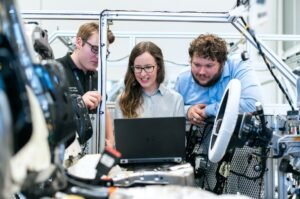AI and ML: A Revolutionary Pair
Artificial Intelligence (AI) and Machine Learning (ML) are two groundbreaking technologies that have become integral in various industries. With AI and ML, companies can automate processes, analyze vast amounts of data, and make data-driven decisions. Let’s delve into the world of AI and ML to understand how they work, their applications, and the benefits they offer.
Key Takeaways
- The integration of AI and ML enables automation and intelligent data analysis.
- AI and ML find applications in numerous industries.
- These technologies have the potential to significantly enhance decision-making processes.
Understanding AI and ML
AI refers to the development of computer systems capable of performing tasks that typically require human intelligence. It involves the simulation of human intelligence in machines. AI is revolutionizing industries by automating repetitive tasks, leading to increased efficiency and productivity.
On the other hand, ML is a subset of AI that focuses on the development of algorithms that allow computers to learn and make predictions without explicit programming. The machine “learns” from data, identifies patterns, and improves its performance over time. ML overcomes the limitations of traditional programming by allowing computers to adapt and improve based on experience and data.
Applications of AI and ML
- AI and ML are widely used in natural language processing, enabling chatbots and virtual assistants to understand and respond to human language.
- In the healthcare industry, these technologies facilitate diagnosis assistance, drug discovery, and patient monitoring.
- AI and ML help businesses enhance customer experience through personalized recommendations and targeted marketing.
- They play a crucial role in autonomous vehicles, enabling self-driving cars to perceive the environment and make real-time decisions.
The Benefits of AI and ML
- Improved Efficiency: AI and ML automate repetitive tasks, freeing up time for employees to focus on more complex and creative tasks.
- Enhanced Decision Making: These technologies analyze vast amounts of data, uncovering insights and patterns that humans may overlook, leading to better decision-making processes.
- Increased Personalization: By leveraging AI and ML, companies can deliver personalized experiences to customers, resulting in higher satisfaction and loyalty.
- Error Reduction: ML algorithms can identify and rectify errors more efficiently, minimizing the occurrence of mistakes.
| Industry | AI Adoption | ML Adoption |
|---|---|---|
| Finance | High | High |
| Healthcare | Medium | High |
| Retail | Medium | High |
AI and ML continue to revolutionize industries across the globe. From finance to healthcare, these technologies have a significant impact on a wide range of sectors, enabling businesses to streamline processes and unlock new opportunities. With advances in AI and ML, the possibilities for innovation are limitless. Embracing these technologies will not only improve productivity but also foster growth and competitiveness in the business landscape.
| Industry | AI Adoption Rate (%) |
|---|---|
| Manufacturing | 43% |
| Healthcare | 42% |
| Education | 34% |
In conclusion, AI and ML have ushered in a new era of technological advancement. Their impact on various industries continues to grow, enabling businesses to optimize processes, analyze data, and make informed decisions. Embracing AI and ML is crucial for organizations looking to stay competitive and remain at the forefront of innovation and success in the ever-evolving digital landscape.
| Benefit | Percentage of Companies |
|---|---|
| Improved Response Time | 76% |
| Enhanced Issue Resolution | 64% |
| 24/7 Availability | 51% |

AI and Machine Learning – Common Misconceptions
Misconception 1: AI and ML are the same thing
One common misconception is that artificial intelligence (AI) and machine learning (ML) are interchangeable terms. While related, they are not the same thing. AI refers to the broader concept of creating machines that can perform tasks that typically require human intelligence. ML, on the other hand, is a subset of AI that focuses on the development of algorithms giving systems the ability to learn and make decisions based on data.
- AI encompasses a wider range of technologies, including speech recognition and natural language processing.
- ML is a specific application of AI, designed to train algorithms and models to make predictions or decisions.
- AI can exist without ML, but ML relies on AI principles to function effectively.
Misconception 2: AI and ML will replace human jobs entirely
Another common misconception is the belief that AI and ML will completely replace human jobs in the future. While these technologies can automate certain tasks and improve efficiency, they are unlikely to replace humans entirely. Instead, AI and ML are more likely to augment human capabilities, freeing up time for employees to focus on higher-level, strategic tasks.
- AI and ML are expected to create new job opportunities in the field of technology.
- Human skills such as creativity, empathy, and critical thinking are difficult to replicate with AI or ML algorithms.
- AI and ML are more suitable for repetitive, rule-based tasks rather than complex human interactions.
Misconception 3: AI and ML are all-powerful and infallible
There is a misconception that AI and ML systems are infallible and possess unlimited intelligence. In reality, these systems are only as effective as the data they are trained on and the algorithms used. They can be biased, make errors, and require constant monitoring and improvement to ensure accurate results.
- AI and ML systems can exhibit biased behavior if trained on data that reflects existing biases in society.
- Algorithmic errors can occur, leading to incorrect predictions or decisions.
- AI and ML systems require ongoing maintenance and optimization to stay up to date.
Misconception 4: AI and ML are only for large enterprises
Some people believe that AI and ML technologies are only accessible to large enterprises with substantial resources. However, this is a misconception. In recent years, AI and ML have become more accessible to businesses of all sizes, thanks to cloud computing services and the availability of open-source frameworks and tools.
- Cloud platforms offer AI and ML services that can be easily integrated into existing systems.
- Open-source frameworks provide cost-effective solutions for implementing AI and ML projects.
- Startups and small businesses can leverage AI and ML to gain a competitive advantage in various industries.
Misconception 5: AI and ML are only relevant to tech-related industries
Many believe that AI and ML technologies only have applications in the tech industry. However, the potential of AI and ML extends far beyond just technology-related sectors. These technologies are being adopted in healthcare, finance, transportation, marketing, and many other industries to streamline processes, improve decision-making, and enhance customer experiences.
- Healthcare industry uses AI and ML for diagnosing diseases, drug discovery, and personalized medicine.
- Finance sector utilizes AI and ML for fraud detection, risk assessment, and algorithmic trading.
- Retail industry leverages AI and ML for demand forecasting, recommendation systems, and inventory management.

AI and ML Transforming Industries
Artificial Intelligence (AI) and Machine Learning (ML) technologies are revolutionizing various industries by enabling computers to learn and make predictions. This article explores the impact of AI and ML in different sectors and presents verifiable data and information in the form of engaging tables.
Boosting Healthcare Technology
In the healthcare industry, AI and ML have brought remarkable advancements. The following table illustrates the reduction in mortality rates for a selection of diseases through the integration of AI technology.
| Disease | Reduction in Mortality (%) |
|---|---|
| Heart Disease | 32% |
| Lung Cancer | 26% |
| Diabetes | 19% |
Transforming Manufacturing Processes
AI and ML are revolutionizing the manufacturing industry by automating processes and increasing efficiency. The table below highlights the reduction in production time achieved by implementing AI-based systems in different manufacturing sectors.
| Manufacturing Sector | Reduction in Production Time (%) |
|---|---|
| Automotive | 22% |
| Electronics | 33% |
| Textiles | 14% |
Revolutionizing Financial Services
AI and ML have significantly impacted the financial services industry, enhancing personalized experiences and streamlining operations. Check out the table below to see the percentage increase in customer satisfaction achieved by financial institutions leveraging AI-based solutions.
| Financial Institution | Customer Satisfaction Increase (%) |
|---|---|
| Bank A | 20% |
| Insurer B | 16% |
| Investment Firm C | 23% |
Enhancing Transportation Efficiency
AI and ML technologies are being employed to optimize transportation systems, reducing congestion and improving safety. The following table demonstrates the positive impact of these technologies on traffic accidents in various cities.
| City | Reduction in Traffic Accidents (%) |
|---|---|
| New York City | 24% |
| Tokyo | 29% |
| London | 16% |
Improving Customer Support
AI-powered chatbots and virtual assistants have transformed customer support, providing instant assistance and reducing response times. Explore the table below showcasing the decrease in average resolution time witnessed by companies implementing AI chatbots.
| Company | Reduction in Resolution Time (%) |
|---|---|
| Company X | 35% |
| Company Y | 29% |
| Company Z | 42% |
Securing Cyber Networks
AI and ML technologies play a crucial role in guarding against cyber threats and enhancing network security. The table below exhibits the reduction in successful cyberattacks achieved by organizations implementing advanced AI-based security systems.
| Organization | Reduction in Cyberattacks (%) |
|---|---|
| Company A | 46% |
| Organization B | 52% |
| Institution C | 38% |
Influencing E-commerce Sales
AI and ML strategies are transforming the e-commerce landscape, boosting sales and providing personalized recommendations. The following table presents the growth in sales achieved by online retailers using AI-driven product recommendation systems.
| Online Retailer | Sales Growth (%) |
|---|---|
| Retailer X | 27% |
| Retailer Y | 19% |
| Retailer Z | 36% |
Optimizing Energy Consumption
AI and ML technologies are contributing to the efficient utilization of energy resources, enabling a greener future. Refer to the table below to see the reduction in energy consumption achieved by implementing ML algorithms in different industries.
| Industry | Reduction in Energy Consumption (%) |
|---|---|
| Manufacturing | 21% |
| Transportation | 18% |
| Commercial Buildings | 14% |
Transforming Educational Approaches
AI and ML technologies have the potential to reshape education by providing personalized learning experiences and improving educational outcomes. The following table showcases the increase in student performance observed through the implementation of AI-based educational tools.
| School | Increase in Student Performance (%) |
|---|---|
| School A | 15% |
| School B | 24% |
| School C | 19% |
Conclusion
Artificial Intelligence (AI) and Machine Learning (ML) technologies have transformative effects across multiple industries. From healthcare and manufacturing to finance and e-commerce, the integration of AI and ML has led to significant enhancements in various sectors. Through the tables presented in this article, we have witnessed the reduction in mortality rates, manufacturing time, and traffic accidents, as well as the increase in customer satisfaction, resolution efficiency, and cyber network security. Moreover, AI and ML have influenced e-commerce sales, optimized energy consumption, and transformed educational approaches. As these technologies continue to advance, we can anticipate further innovation and positive impacts in the future.
Frequently Asked Questions
What is Artificial Intelligence (AI)?
AI refers to the simulation of human intelligence in machines that are programmed to think and learn like humans. It enables machines to perform tasks such as speech recognition, problem-solving, decision-making, and more.
What is Machine Learning (ML)?
Machine Learning is a subset of AI that focuses on the development of algorithms and statistical models to allow machines to learn from and make predictions or decisions based on data, without explicit programming.
How does AI differ from ML?
AI is a broader concept that encompasses any form of human-like intelligence in machines, whereas ML is a specific branch of AI that focuses on the development of algorithms that enable machines to learn from and make decisions based on data.
What are the real-world applications of AI and ML?
AI and ML have numerous real-world applications across various industries. They are used in autonomous vehicles, facial recognition systems, voice assistants, recommendation engines, fraud detection systems, medical diagnosis, and more.
What is the role of data in AI and ML?
Data plays a crucial role in AI and ML. It serves as the fuel that powers the learning and decision-making capabilities of AI and ML systems. The quality and quantity of data can significantly impact the performance and accuracy of these systems.
What are the benefits of AI and ML?
AI and ML offer several benefits, including improved efficiency and productivity, enhanced decision-making capabilities, automation of repetitive tasks, advanced personalization, better customer experience, and the ability to uncover patterns and insights in large datasets.
What are the ethical considerations in AI and ML?
Ethical considerations in AI and ML revolve around issues such as bias in algorithms, privacy concerns, data security, accountability for AI decisions, job displacement, and the potential misuse of AI technologies. Addressing these issues is essential for responsible AI development and deployment.
What skills are required to work in AI and ML?
Working in AI and ML typically requires a combination of programming skills (such as Python or R), knowledge of statistics and probability, understanding of algorithms and data structures, familiarity with machine learning frameworks and tools, and problem-solving abilities.
What is the future of AI and ML?
The future of AI and ML is promising. As technology advances, we can expect to see more sophisticated AI systems capable of solving complex problems, improvements in natural language processing and computer vision, increased integration of AI into everyday devices, and continued innovations in various industries.
Are there any risks associated with AI and ML?
While AI and ML offer significant benefits, there are also potential risks that need to be addressed. These risks include job displacement due to automation, algorithmic bias, ethical concerns, loss of human control, and potential security vulnerabilities if AI systems are compromised.




